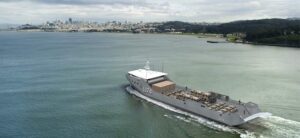
The Marine Corps is exploring several ways to move groups of Marines around the Indo-Pacific region while waiting for the Light Amphibious Warship (LAW), which been pushed back several years. The service’s annual Force Design 2030 update, released on May 9, said that given mobility requirements, the Marine Corps must invest in littoral maneuver capabilities in a Medium Landing Ship (LSM) beyond the traditional larger L-class amphibious ships, notably through the LAW. “While we await the delivery of LSM, which…

 By
By 








